Holding the trombone can be daunting at first and knowing which hand goes where and if you’re even doing it properly can be confusing. More importantly, if you learn bad habits and wrong technique it can hold you back and mean you have to start all over again.
In this article we will talk about how to hold a trombone properly and get a comfortable grip that’s safe for you and your instrument. The contents of this article will also form the foundations of your technique, so it’s worth thinking about!
The Left-Hand Grip
Let’s first start with what we do with the left hand.
When it comes to playing the trombone, the left hand’s job is to support the weight of the instrument, gripping the first slide brace and the second bell brace:

The most common handgrip is like the letter ‘L’ or a finger gun:
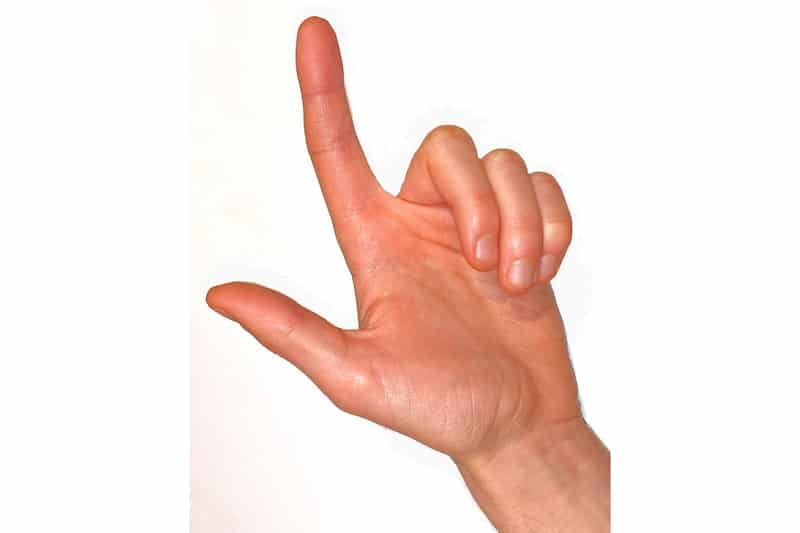
Here the middle two and pinky finger grip the slide brace, the first finger loops over the top, and the thumb wraps around the bell brace or trigger.
Below is an example with an F attachment (the thumb will wrap around the trigger rather than the bell brace):

Try keep your wrist straight so that the weight of the instrument travels down your arm.
It’s worth noting that those with smaller hands may struggle with this grip at first and may need to modify the hand position.
But providing the grip is strong and stable this will be fine but try to aim for the above if you can.
If you’re really struggling with the weight, you can also buy a strap that will take the weight off your fingers and onto the palm of the hand like in the image below.
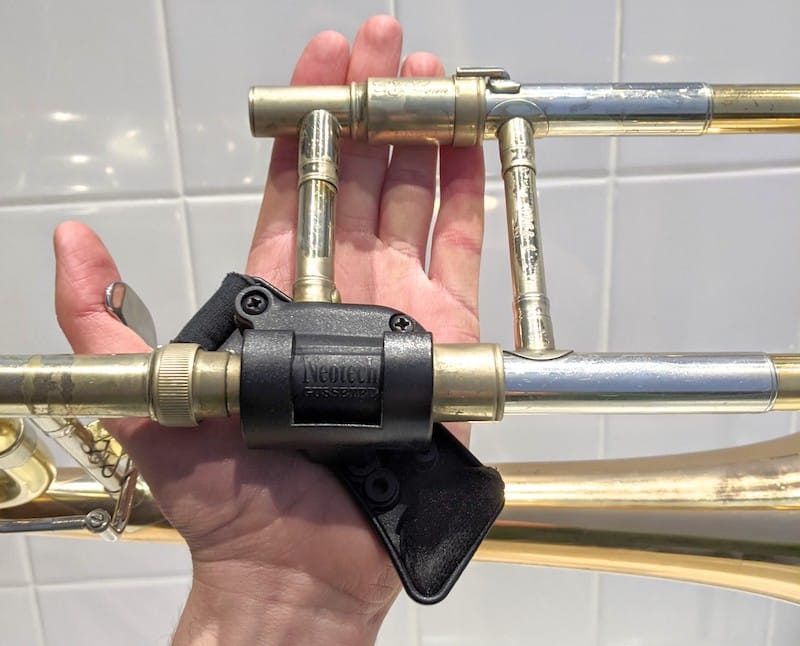
If you have any discomfort in the left hand it’s worth getting one as they are very inexpensive, here’s the one I have:
- Creates a comfortable custom grip to support the weight of the instrument
- Easy to attach and adjustable to 18 positions
- Fits most trombones
Sometimes wrist pain develops over time and if it does it shouldn’t be ignored and grab a strap.
Another thing to mention is that when you’re playing with a mute you’ll use the left hand to hold a mute.
When this is the case, the weight of the instrument is held via the bell, which rests on your wrist or palm.
Holding the Slide
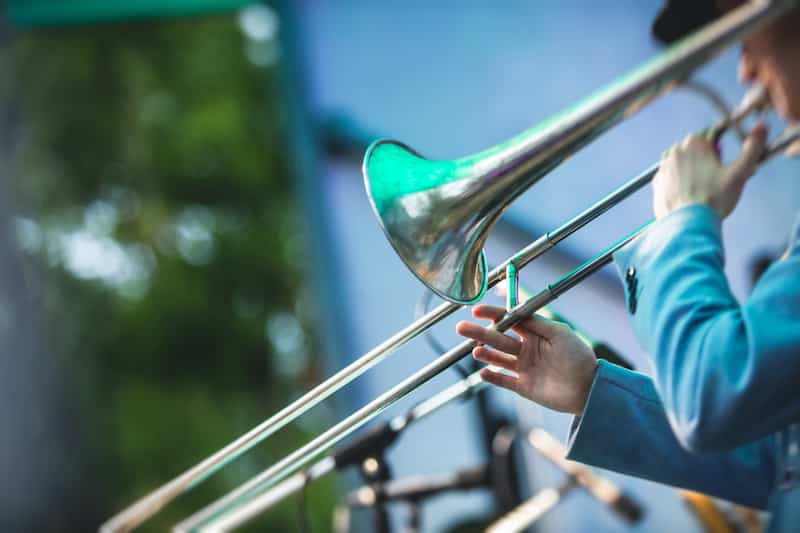
The trombone is very unique among instrumetsn in that its pitch is controlled by a moveable slide.
As the slide is extended it increases the distance the air has to travel through the instrument which causes the pitch to be lower.
When it comes to gripping the slide, you should hold the 2nd slide brace and then extend your arm.
While the slide can be gripped in several ways, there are some general rules that will be beneficial for your slide technique in the long run.
You want to hold the slide brace at the bottom corner by pinching it between your first and 2nd fingers and thumb as shown in the image below.
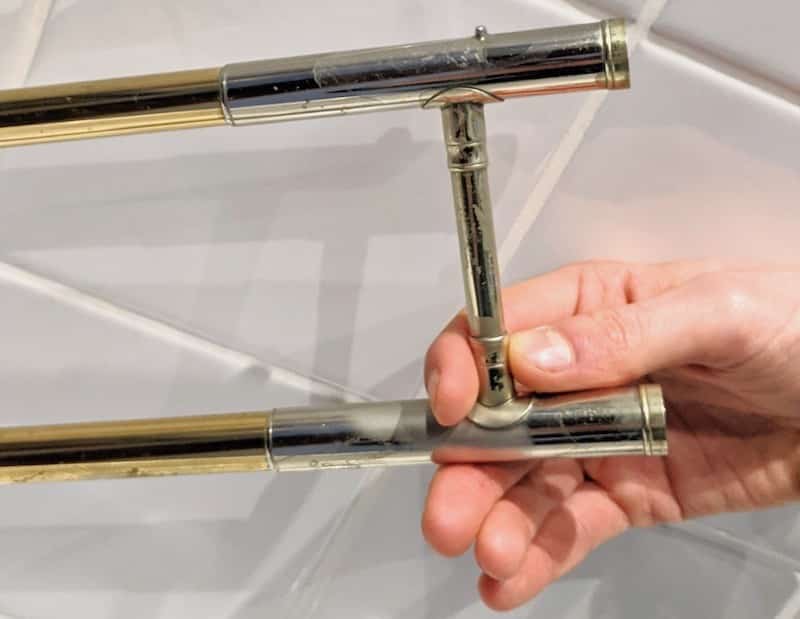
Holding the slide at the bottom and with your fingers gives you a longer reach.
It’s also important to keep your other fingers below the slide as this will help you not only support the weight but allow to be able to let go of your thumb for extra reach which helps with seventh position.
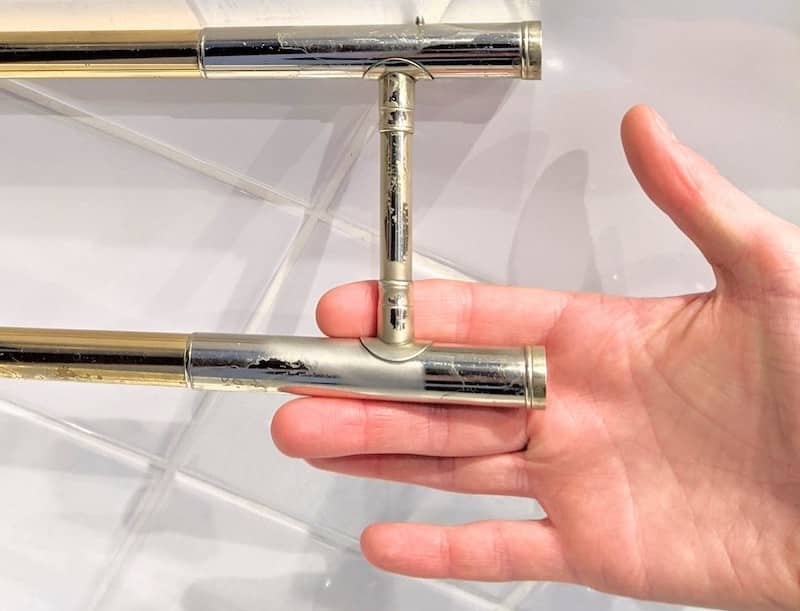
The last thing to mention about gripping your trombone slide is that you should keep your wrist straight and take care to not move it when moving the slide, and just use your arm.
Moving your wrist and arm simultaneously involves too many joints and it will be difficult to move the slide precisely.
To help keep your wrist still, try angle the back of your hand parallel to the slide as it’s much harder to move your wrist side to side than up and down!
Trombone Posture
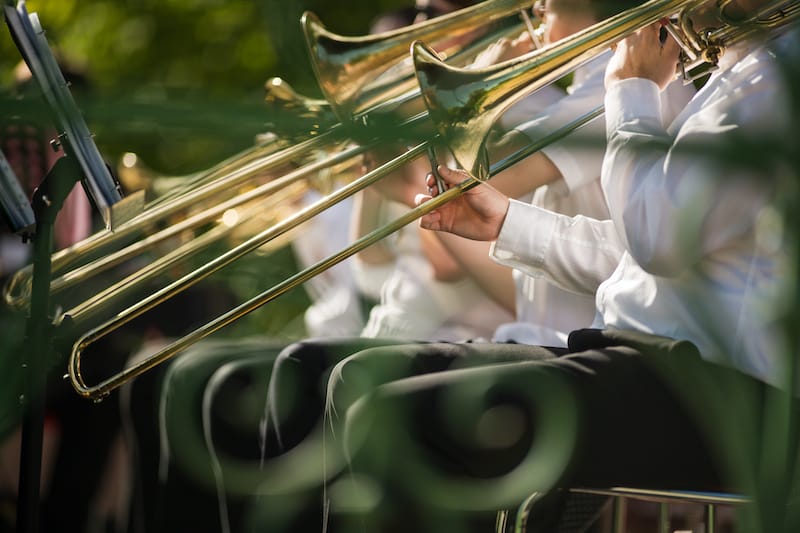
Most people know that musicians need to have good posture in order to play and the trombone is no exception.
For trombonists it means the same thing as most other instruments: keep your head up, shoulders back, back straight, stomach in (not puffed out) and if sat down, sit up straight
But, the most important thing to consider is that you are comfortable, and able to breathe effectively.
When it comes to the angle of the trombone, try to keep it pointing below horizontal, and above 45o to the ground.
It can be tempting to play upwards for the sake of projection, keeping the instrument a little lower can make you more comfortable.
If you’re reading, position the music stand so that this angle is natural, standing to the left so the bell flare doesn’t obscure the music.
And try to keep both your elbows at a similar height pointing at a roughly 45o angle to the ground.
Keep an eye on how your shoulders are and try to keep them down, although you may need to extend them slightly for seventh position.
You may also need to angle the slide further downwards to help with these long positions.
Another thing to look out for is that you make sure to bring the instrument to your face, rather than moving your head and neck towards the mouthpiece.
Moving your neck in this way creates tension which may interfere with your breathing and cause injury or discomfort if done for prolonged periods.
As always with posture, if something hurts then stop and consult a specialist.
The trombone is a heavy instrument, and its centre of gravity is almost always in front of you.
This can put a lot of strain on your back and shoulders; for this reason it is often advised that you perform a physical warm up before extended periods of playing.
That’s it for Holding the Trombone
That’s it for our guide on how to hold the trombone, I hope it helps to explain the basics as well as some of the more nuanced parts.
Although it may seem obvious and not worth thinking about, how you hold the trombone is incredibly important as holding the trombone well can improve your technique and prevent injury.
It is very difficult to unlearn the fundamentals of your technique, so I would advise considering your hold of the instrument early on in your playing career.
Staying comfortable, while good for your physical health, is also great for your technique and musicianship.
Tension can hold your technique back in the long run, and it distracts you from engaging with the music.
If nothing else, playing the trombone (or any instrument) is much more fun when it feels easy!

